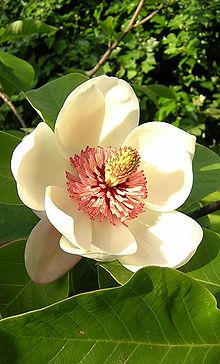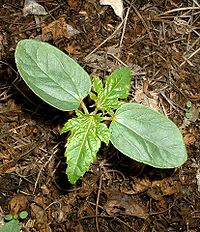- Dicotyledon
-
Magnoliopsida (Dicotyledons) 
Scientific classification Kingdom: Plantae Phylum: Magnoliophyta Class: Magnoliopsida*
BrongniartIncluded groups - Eudicot
- Magnoliid
- Amborella
- Nymphaeales
- Austrobaileyales
- Chloranthales
- Ceratophyllum
Excluded groups  Young castor oil plant showing its prominent two embryonic leaves (cotyledons), that differ from the adult leaves.
Young castor oil plant showing its prominent two embryonic leaves (cotyledons), that differ from the adult leaves.
The dicotyledons, also known as dicots, are a group of flowering plants whose seed typically has two embryonic leaves or cotyledons. There are around 199,350 species within this group.[1] Flowering plants that are not dicotyledons are monocotyledons, typically having one embryonic leaf.
Dicotyledons are not a monophyletic group, and therefore the names "dicotyledons" and "dicots" are, strictly speaking, deprecated. However, the vast majority of "dicots" do form a monophyletic group called the eudicots or tricolpates. These may be distinguished from all other flowering plants by the structure of their pollen. Other dicotyledons and monocotyledons have monosulcate pollen, or forms derived from it, whereas eudicots have tricolpate pollen, or derived forms, the pollen having three or more pores set in furrows called colpi.
Traditionally the dicots have been called the Dicotyledones (or Dicotyledoneae), at any rank. If treated as a class, as in the Cronquist system, they may be called the Magnoliopsida after the type genus Magnolia. In some schemes, the eudicots are treated as a separate class, the Rosopsida (type genus Rosa), or as several separate classes. The remaining dicots (palaeodicots) may be kept in a single paraphyletic class, called Magnoliopsida, or further divided.
Contents
Compared to Monocotyledons
Aside from cotyledon number, other broad differences have been noted between monocots and dicots, although these have proven to be differences primarily between monocots and eudicots. Many early-diverging dicot groups have "monocot" characteristics such as scattered vascular bundles, trimerous flowers, and non-tricolpate pollen. In addition, some monocots have dicot characteristics such as reticulated leaf veins.
Feature In monocots In dicots Number of parts of each flower in threes (flowers are trimerous) in fours or fives (tetramerous or pentamerous) Number of furrows or pores in pollen one three Number of cotyledons (leaves in the seed) one two Arrangement of vascular bundles in the stem scattered in concentric circles Roots are adventitious develop from the radicle Arrangement of major leaf veins parallel reticulate Classification
APG (Angiosperm Phylogeny Group) vs. Cronquist Classification
The following lists are of the orders formerly placed in the dicots, giving their new placement in the APG-system and that under the older Cronquist system, which is still in wide use.
Dahlgren and Thorne systems
In the Dahlgren and the Thorne systems, the name Magnoliidae is used for the dicotyledons. This is also the case in some of the systems derived from the Cronquist system. For each system, only the superorders are listed. The sequence of each system has been altered to pair corresponding taxa, although circumscription of superorders with the same name is not always the same. The Thorne system (1992) is the version of the system as depicted by Reveal.
Comparison of the Dahlgren and Thorne systems Dahlgren system Thorne system Magnolianae
Ranunculanae
Magnolianae
Rafflesianae
Nymphaeanae Nymphaeanae Caryophyllanae Caryophyllanae Theanae
Plumbaginanae
Polygonanae
Primulanae
EricanaeTheanae Malvanae Malvanae Violanae Violanae Rosanae Rosanae Proteanae Proteanae Myrtanae Myrtanae Rutanae Rutanae
Celastranae
GeranianaeSantalanae Santalanae Balanophoranae Santalanae Asteranae Asteranae Solananae Solananae Cornanae
Vitanae
Cornanae
Aralianae
Loasanae Loasanae Dicotyledons Gentiananae
Lamianae
Gentiananae References
- ^ Hamilton, Alan; Hamilton, Patrick (2006), Plant conservation : an ecosystem approach, London: Earthscan, pp. 2, ISBN 9781844070831, http://books.google.com/?id=P6m0OTheY8sC&printsec=frontcover#PPA2,M1
Categories:
Wikimedia Foundation. 2010.
